The United States is widely known for its Great Lakes: Lake Superior, Lake Michigan, Lake Huron, Lake Ontario, and Lake Erie. Famous for being the largest freshwater lakes globally, the volumes of the Great Lakes contribute greatly to the total volume of Earth’s lakes.
Lake Superior, the largest lake in the United States, is also the third-largest lake on the entire planet by volume, just trailing behind Lake Baikal in Siberia and Lake Tanganyika in East Africa. The total volume of Earth’s lakes is 199,000 cubic kilometers, and Lake Superior alone takes about 15 percent, with a volume of 12,100 cubic kilometers! Aside from the Great Lakes, the United States also boasts of lakes with water volumes of more than 100 cubic kilometers. Based on their water volume, these massive lakes surpass all other lakes in the United States.
So, what are the largest lakes by volume in the United States, and how enormous is the amount of water they contain under normal conditions? Ranked from smallest to largest, this article explores the 10 largest lakes by volume in the United States.

10. Lake Clark

Lake Clark is 40 miles long and 5 miles wide.
©iStock.com/Alexei Perelygin
Volume: 31.7 cubic kilometers (7.6 cubic miles)
The smallest lake on our list is Lake Clark, the 10-largest lake by volume in the United States, with a volume of 31.7 cubic kilometers. This Alaska lake is found within Lake Clark National Park and Preserve. Lake Clark drains into Iliamna Lake through two inflows: Six Mile Lake and Newhalen River. It is about 40 miles (64 kilometers) long and 5 miles (8 kilometers) wide. Lake Clark was named after a person, John W. Clark, who was the first American non-Native to see the lake. It was given a Native name Qizjeh Vena, which means “place where people gather lakes” — a name that gives credence to how huge this body of water is.
9. Becharof Lake

Flooded with water and sockeye salmon, massive Becharof is a highly desired destination for anglers.
©R.J. Wilk, U.S. Fish and Wildlife Service (US-FWS) / Public domain, from Wikimedia Commons, the free media repository – License
Volume: 44.0 cubic kilometers (10.56 cubic miles)
With a water volume of 44.0 cubic kilometers, Becharof Lake ranks ninth on the list of largest lakes by volume in the United States. It is also the second-largest lake in Alaska, after Iliamna Lake. Becharof Lake was named after Dmitry Bocharov, a Russian navigator who explored the lake upon traveling up the Egegik Bay in search of a portage. It is the 14-largest lake in the United States by surface area, at 453 square miles (1,170 square kilometers).
8. Lake Pend Oreille

Lake Pend Oreille has a water volume of 54.2 cubic kilometers and a depth of 1,150 feet.
©Jeffrey T. Kreulen/Shutterstock.com
Volume: 54.2 cubic kilometers (13 cubic miles)
Lake Pend Oreille is located in the U.S State of Idaho. It has a water volume of 54.2 cubic kilometers and a depth of 1,150 feet (350 meters), making it the eighth-largest lake by volume and the fifth-deepest lake in the United States. With a surface area of 148 square miles, it is the largest lake in Idaho. Lake Pend Oreille is surrounded by a national forest and is home to several species of migratory birds and trout species, including the state-recorded 37-pound Gerrard rainbow trout captured in 1947.
7. Iliamna Lake
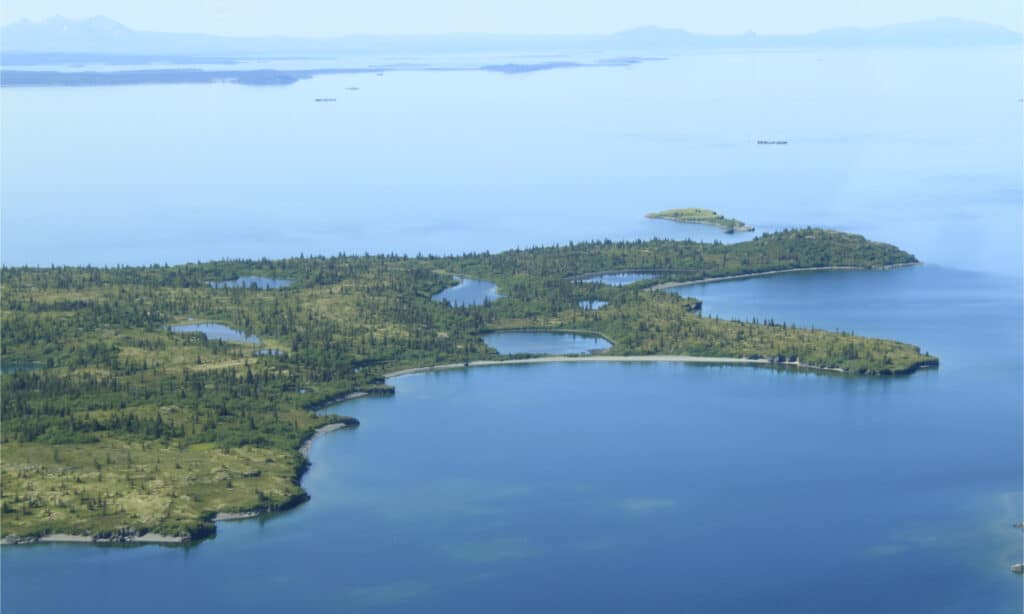
Iliamna Lake drains into Bristol Bay via the Kvichak River.
©Nessie91/Shutterstock.com
Volume: 116.1 cubic kilometers (28 cubic miles)
Iliamna Lake is the seventh-largest lake by volume in the United States. Covering a surface area of 2,626 square kilometers, Iliamna Lake is also the eighth-largest lake by surface area in the United States and the largest freshwater lake in Alaska. Many rivers and streams drain into Iliamna Lake, including the Newhalen River, Iliamna river, Pile River, and Copper River, contributing to its large water volume of 116.1 cubic kilometers. Iliamna Lake drains into Bristol Bay via the Kvichak River and is known to be one of the most popular sources of sockeye salmon in the Bay region. Iliamna Lake is popular for sports fishing, and it is home to one of the few populations of freshwater seals in the world.
6. Lake Tahoe
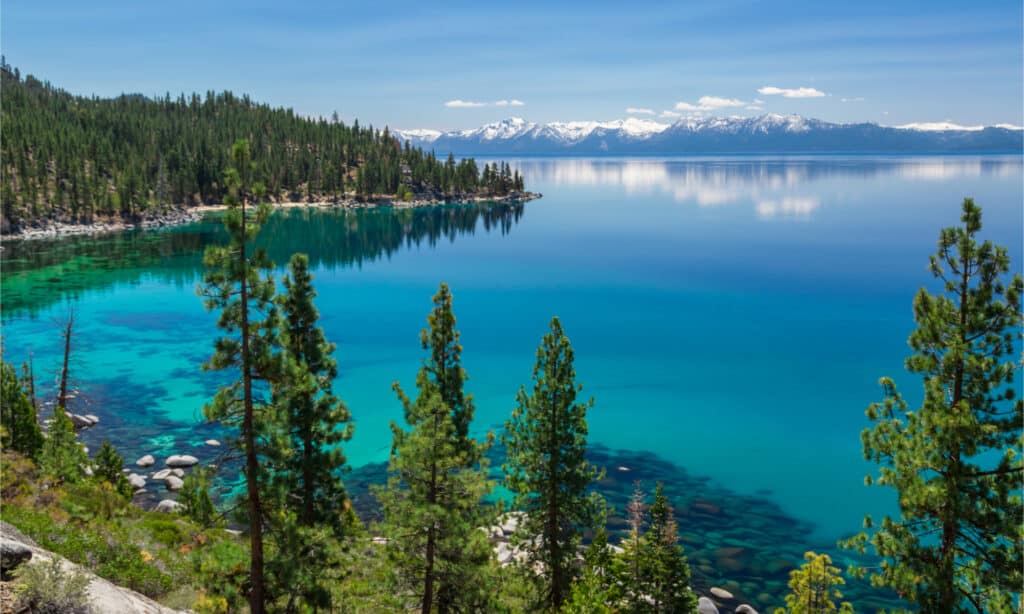
Lake Tahoe has an average depth of 1,000 feet.
©topseller/Shutterstock.com
Volume: 150.7 cubic kilometers (36 cubic miles)
With a water volume of 150.7 cubic millimeters, Lake Tahoe is surpassed only by the Great Lakes as the largest lake by volume in the United States. It is located in the Sierra Nevada, along the state line of California and Nevada. Lake Tahoe has an average depth of 1,000 feet. To reach its deepest point, you’d need to descend 1,645 feet (501 meters), which makes it the second-deepest lake in the United States, after Crater Lake. Even though it is not as large as the Great Lakes, it undoubtedly contains a massive volume of water.
5. Lake Erie
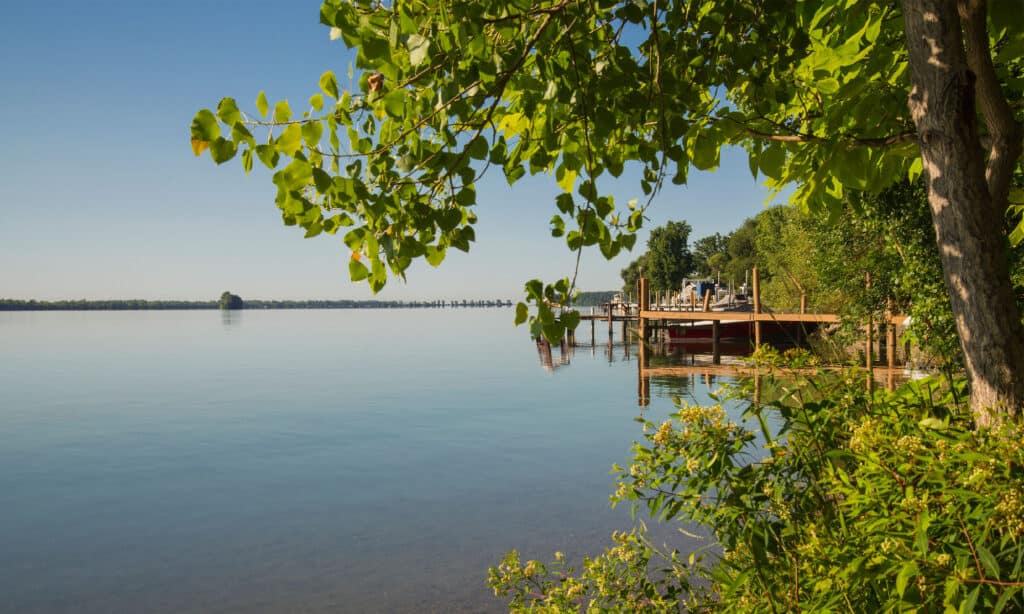
Lake Erie is the smallest by volume of the Great Lakes, with a water volume of 115 cubic miles.
©iStock.com/JerryB7
Volume: 480 cubic kilometers (115 cubic miles)
Situated on the boundary between Canada and the United States, Lake Erie is the fifth-largest lake by volume in the United States. By surface area, it is the fourth-largest lake in the United States and the eleventh-largest lake in the world. Lake Erie is the smallest by volume of the Great Lakes, with a water volume of 480 cubic kilometers. Not only is it the smallest, but it is also the shallowest of all the Great Lakes, with an average depth of 63 feet (19 meters). Because of its shallowness, it is the warmest of the Great Lakes and the first to freeze in the winter.
4. Lake Ontario

With a water volume of 390 cubic miles, Lake Ontario is the fourth-largest lake by volume in the United States.
©Michael J. Eves/Shutterstock.com
Volume: 1,640 cubic kilometers (390 cubic miles)
Lake Ontario is the smallest of the Great Lakes in surface area, covering 7,340 square miles. However, it exceeds one of the Great Lakes — Lake Erie — in volume. With a water volume of 1,640 cubic kilometers, Lake Ontario is the fourth-largest lake by volume in the United States. Unlike all the other Great Lakes, it is the only lake not to border the state of Michigan. Lake Ontario is surrounded on the north, west, and southwest by Ontario and on the South and east by New York. Because of how massive it is, Lake Ontario is home to a diverse collection of plants, birds, fish, reptiles, and amphibians.
3. Lake Huron
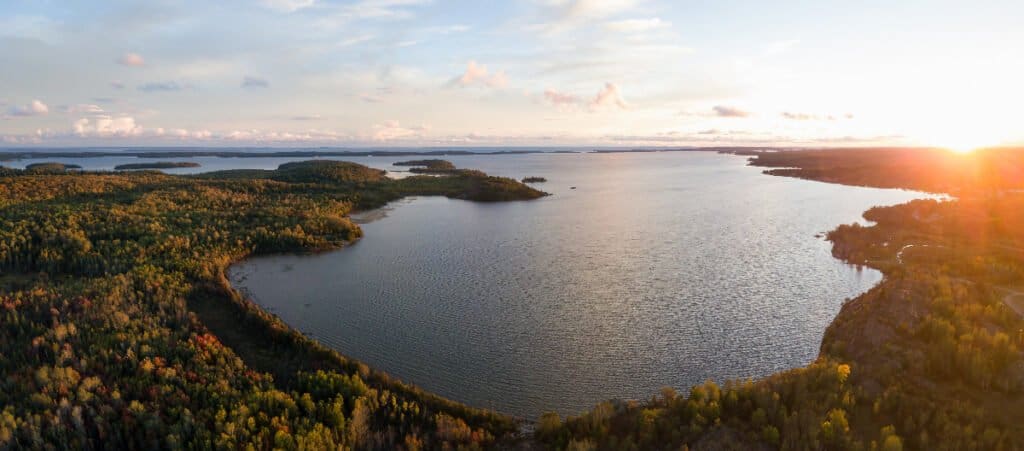
Lake Huron is a large lake that is connected with Lake Michigan.
©EB Adventure Photography/Shutterstock.com
Volume: 3,543 cubic kilometers (850 cubic miles)
Lake Huron is the other half of Lake Michigan – Huron, two massive lakes sometimes considered a single lake. The two Great Lakes join via the narrow open-water Straits of Mackinac to form the largest body of freshwater in the world by surface area. Apart from its large surface area, Lake Huron contains a water volume of 3,500 cubic kilometers (850 cubic miles), making it the third-largest of the Great Lakes by volume. This vast body of water shares its borders with Ontario, Canada, and Michigan. Lake Huron was named by early French explorers after the Huron people inhabited the region.
2. Lake Michigan
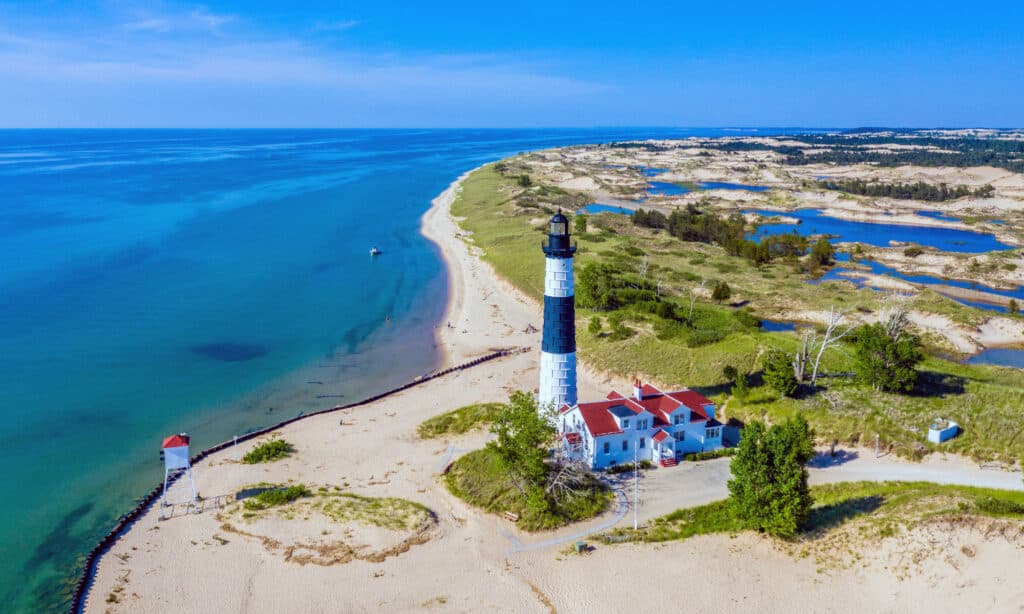
Lake Michigan is the only Great Lake that shares no borders with other countries.
©Frederick Millett/Shutterstock.com
Volume: 4,900 cubic kilometers (1175 cubic miles)
The second-largest of the Great Lakes by volume is Lake Michigan, with a volume of 4,900 cubic kilometers. It is also the third-largest lake in the United States based on its surface area, which covers 22,404 square miles. The massive Lake Michigan is the only Great Lake that shares no borders with other countries; its borders are entirely within the United States. About 12 million people live along the shores of the lake. There are also several cities on its shores, including Illinois, Indiana, Michigan, and Wisconsin.
1. Lake Superior
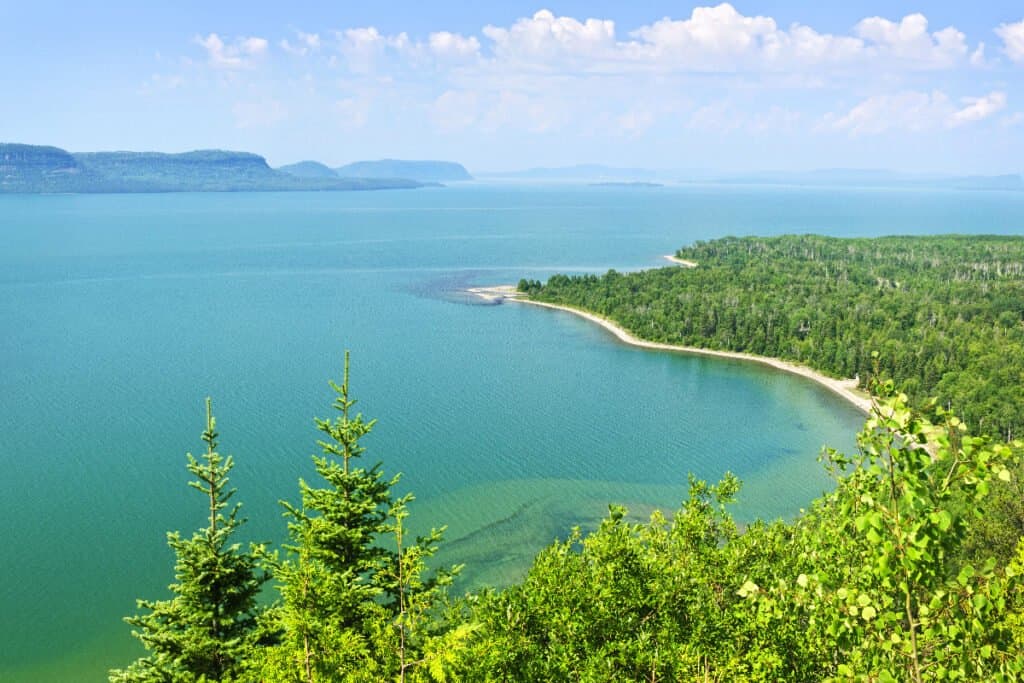
Lake Superior has 10% of the world’s surface freshwater and is the largest lake by volume in the U.S.
©Elena Elisseeva/Shutterstock.com
Volume: 12,100 cubic kilometers (2900 cubic miles)
From its history, Lake Superior was named “on account of its being superior to any of the lakes on the vast continent.” It’s not surprising that Lake Superior is the largest lake by volume in the United States and the third-largest lake in the world. This lake holds more water than all other Great Lakes combined, plus three more Lake Eries — about 3 quadrillion gallons of water! Lake Superior holds 10% of the world’s freshwater, making it the largest freshwater lake by surface area in the world at 31,700 square miles. With such an enormous water volume (12,100 cubic kilometers) and depth (1,333 feet), trying to empty it at the current rate would take 191 years. Yes, that’s how massive Lake Superior is!
Summary of the 10 Largest Lakes by Volume in the United States
| Rank | Lake | Location | Volume |
|---|---|---|---|
| 1 | Lake Superior | Wisconsin, Michigan, Minnesota, and Ontario, Canada | 2,900 cubic miles |
| 2 | Lake Michigan | Illinois, Indiana, Michigan, Wisconsin | 1,175 cubic miles |
| 3 | Lake Huron | Michigan and Ontario, Canada | 850 cubic miles |
| 4 | Lake Ontario | New York and Ontario, Canada | 390 cubic miles |
| 5 | Lake Erie | Michigan, Ohio, Pennsylvania, New York, and Ontario, Canada | 115 cubic miles |
| 6 | Lake Tahoe | Sierra Nevada, California; Nevada | 36 cubic miles |
| 7 | Iliamna Lake | Southwestern Alaska | 28 cubic miles |
| 8 | Lake Pend Oreille | Northern Idaho Panhandle | 13 cubic miles |
| 9 | Becharof Lake | Aleutian Range of the Alaska Peninsula in Southwestern Alaska | 10.56 cubic miles |
| 10 | Lake Clark | Port Alsworth, Alaska | 7.6 cubic miles |
The photo featured at the top of this post is © Jeffrey T. Kreulen/Shutterstock.com
Thank you for reading! Have some feedback for us? Contact the AZ Animals editorial team.







